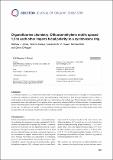Files in this item
Organofluorine chemistry : difluoromethylene motifs spaced 1,3 to each other imparts facial polarity to a cyclohexane ring
Item metadata
| dc.contributor.author | Jones, Mathew J. | |
| dc.contributor.author | Callejo, Ricardo | |
| dc.contributor.author | Slawin, Alexandra M. Z. | |
| dc.contributor.author | Bühl, Michael | |
| dc.contributor.author | O'Hagan, David | |
| dc.date.accessioned | 2017-01-13T12:30:15Z | |
| dc.date.available | 2017-01-13T12:30:15Z | |
| dc.date.issued | 2016-12-22 | |
| dc.identifier | 248876730 | |
| dc.identifier | 9d3cc624-dde4-4ab6-ad62-f282bf58c865 | |
| dc.identifier | 85008164832 | |
| dc.identifier | 000391508600001 | |
| dc.identifier.citation | Jones , M J , Callejo , R , Slawin , A M Z , Bühl , M & O'Hagan , D 2016 , ' Organofluorine chemistry : difluoromethylene motifs spaced 1,3 to each other imparts facial polarity to a cyclohexane ring ' , Beilstein Journal of Organic Chemistry , vol. 12 , pp. 2823-2827 . https://doi.org/10.3762/bjoc.12.281 | en |
| dc.identifier.issn | 1860-5397 | |
| dc.identifier.other | ORCID: /0000-0002-1095-7143/work/48131760 | |
| dc.identifier.other | ORCID: /0000-0002-9527-6418/work/56861830 | |
| dc.identifier.other | ORCID: /0000-0002-0510-5552/work/68281271 | |
| dc.identifier.uri | https://hdl.handle.net/10023/10095 | |
| dc.description | This work was supported by the Engineering and Physical Sciences Research Council (EPSRC) and the European Research Council (ERC). The authors acknowledge the EPSRC National Mass Spectrometry Facility (Swansea). D.O’H. thanks the Royal Society for a Wolfson Research Merit Award. | en |
| dc.description.abstract | 2,2-Dimethyl-5-phenyl-1,1,3,3-tetrafluororocyclohexane has been prepared and characterised as an example of a facially polarised cyclohexane containing 1,3 related CF2 groups. The dipolar nature of the ring arises from the axial orientation of two of the C-F bonds pointing in the same direction, and set by the chair conformation of the cyclohexane. This electrostatic profile is revealed experimentally both in the solid-state (X-ray) packing of the rings and by solution (NMR) in different solvents. A computationally derived electrostatic profile of this compound is consistent with a more electronegative and a more electropositive face of the cyclohexane ring. This placing of CF2 groups 1,3 to each other in a cyclohexane ring is introduced as a new design strategy which could be applicable to the preparation of polar hydrophobic cyclohexane motifs. | |
| dc.format.extent | 5 | |
| dc.format.extent | 2170260 | |
| dc.language.iso | eng | |
| dc.relation.ispartof | Beilstein Journal of Organic Chemistry | en |
| dc.subject | Aliphatic rings | en |
| dc.subject | C-F bond | en |
| dc.subject | Cyclohexane conformation | en |
| dc.subject | Difluoromethylene group | en |
| dc.subject | Organofluorine chemistry | en |
| dc.subject | QD Chemistry | en |
| dc.subject | Organic Chemistry | en |
| dc.subject | DAS | en |
| dc.subject.lcc | QD | en |
| dc.title | Organofluorine chemistry : difluoromethylene motifs spaced 1,3 to each other imparts facial polarity to a cyclohexane ring | en |
| dc.type | Journal article | en |
| dc.contributor.sponsor | EPSRC | en |
| dc.contributor.institution | University of St Andrews. School of Chemistry | en |
| dc.contributor.institution | University of St Andrews. EaSTCHEM | en |
| dc.contributor.institution | University of St Andrews. Biomedical Sciences Research Complex | en |
| dc.identifier.doi | https://doi.org/10.3762/bjoc.12.281 | |
| dc.description.status | Peer reviewed | en |
| dc.identifier.grantnumber | EP/K022946/1 | en |
This item appears in the following Collection(s)
Items in the St Andrews Research Repository are protected by copyright, with all rights reserved, unless otherwise indicated.

